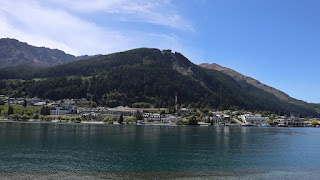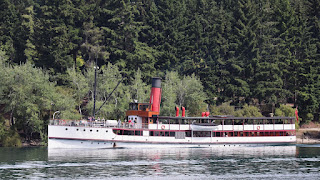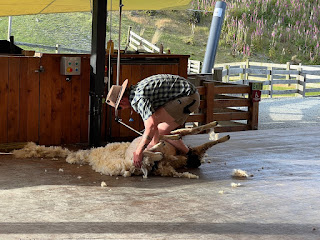Day 73: 20231205 Tuesday, December 5, 2023- Milford Sound Disembarkation for overland overnight Excursion
The ship boarded her local pilot just outside the entrance of Milford Sound on the South Island of New Zealand at 6am as we had a quick breakfast in our stateroom. The entrance to Milford Sound is very narrow, so it is a bit of a wonder that explorers of old bothered to enter and explore it. Before the advent of steam powered vessels, exploring narrow bodies of water reliant on wind was fraught with hazards and risk.
We had to head down to the Princess Theater at 7:15am with our luggage so there wasn’t much time for us to view Milford Sound but the views from our port side staterooms were excellent. We were able to see Sterling Falls, which is the largest permanent water falls before we had to head down.
We didn’t realize how little time it would take the Royal Princess to sail up to the head of Milford Sound, which is only about 9 miles long. It seemed like it took longer to sail up it when we did it in the Golden Princess in 2017 with Jack and Sharon, but by 8am, the ship had reached Milford harbor and Lady Bowen’s Falls where we rendezvoused with a small passenger ferry tied up to the side of the ship on deck 4 where the pilots normally transit on and off the ship.
We discovered that this overland excursion had only 16 participants, so it is a small group excursion. We also discovered 3 other couples that had done the Uluru land tour were also doing this tour. I guess that’s just proof the great minds think alike.
The little ferry got us a really close up view of Lady Bowen’s falls as it took us to the Marina at Milford Harbor.
A full sized tour coach was waiting for us so we had plenty of room to spread out. Our Driver/guide, Mark, is a lifelong Kiwi who has lived on both North and South Islands. He has a good sense of humor and seems to enjoy doing these tours. Because we have a small group, we were able to make frequent photo stops and he even made some bonus stops.
The fjord at Milford sound is very impressive, with mountains soaring more than a thousand feet on either side of the ship, just like in Norway’s fjords. Driving up the Cleddau valley is no less spectacular. We stopped at the Tutoko river to walk across a pedestrian suspension bridge as we headed up the valley. The lush rain forest was filled with the sounds of birds in the trees. We saw a couple of Keas eventually dash from one tree to another across the road as we were reboarding the bus to leave.
We came to what appeared to be a dead end box canyon with vertical sides rising nearly a thousand feet. The way out of the canyon is through the Homer Tunnel, which was started as a Depression Era works project, with men digging with pick axes and shovels through the Darran mountain range 1.2km. It took until 1954 to complete because of delays caused by WWII and a deadly avalanche in 1945.
It is wide enough for one bus and one car to pass each other, but is operated as a one way tunnel via stop lights at either end. We entered the west entrance where it was heavily overcast and cool. We emerged the east end into brilliant sunshine and much warmer temperatures. The Milford Sound highway continues through deep glacial valleys which make up a lot of the South Island of New Zealand and the Southern Alps. The scenery is spectacular- no wonder it was used so much in filming the Lord of the Rings movies.
We made a roadside stop to admire the valley on the east side of the tunnel and encountered a pair of Keas in the parking lot fooling around with pebbles. The Keas are very intelligent and curious, but can also cause all sorts of mischief. They are endangered, but they have been known to rearrange traffic cones to slow traffic, pick through backpacks or rummage through cars or tents, and steal things like Go-Pro cameras and watches. There are signs warning people not to feed them and to make sure their car doors and windows are closed to discourage this sort of mischief.
The next stop was along a mirror lakes trail along Lake Te Anau, which was a short boardwalk paralleling the road. There were a lot of local tourists traveling both ways along this boardwalk. There was a bit too much vegetation overgrowth and too many ducks swimming in the water for a great mirror reflection of the mountains on the other side of the valley, but the views were still grand.
On our way to our lunch stop we made an unscheduled detour to see a very rare takahē flightless parrot in a bird sanctuary. It had fortunately come to the front of its enclosure when we dropped in so we could get a good look at him. There was also another endangered rare bird- a mountain parrot that is very much like the Kea, but with different coloration and range. This bird was initially working at something at the front of his enclosure, but before we could get a picture through the cage mesh, he flew to the back of his enclosure into a hiding box.
Lunch was in the city of Te Anau at a place called The Ranch Bar and Grill. It had a country and western theme with movie posters. We had a very good lamb shank lunch there including soda, beer or wine. It was served with au jus on mash and peas. We had a little time to walk about the town, so our Driver/Guide took us down the street to see a massive jade boulder the size of a small donkey in a gift shop. Price and Ciara ended buying some souvenirs there.
When we exited the Milford Sound National Park, the hillsides showed evidence of habitation and development such as the introduction of non-native species like pines planted for construction lumber because all the native species were slow growing hard woods. There are also fencing and live stock including sheep, cattle and even deer. The Kiwi’s manage to contain deer with a 7 foot fence or “eye level” because the deer want to stay with their herds, but in our experience, a 7 foot fence is no obstacle for a deer who wants to get to the other side. There is also plenty of Gorst, which apparently had at one time been used to create hedges in England to contain cattle, but has now simply become a real pest of an invasive species. Along with that is Scotch broom.
The latitude of parts of the Southern Island match the latitude of our Pacific Northwest home so many of the same invasive species are present, and some of our useful species such as Douglas Fir have been planted intentionally for commercial purposes in New Zealand. Not all introductions end in disaster, but many past introductions were responsible for the loss of over 50% of New Zealand’s native bird species, particularly those ones who are flightless. New Zealand had only one native mammal before humans arrived, and that was a small bat. The most problematic introductions were stoats and possums which love ground nesting birds and eggs. The national bird, the Kiwi, faces extinction because of these animals, so there are traps everywhere to try to control the numbers of these animals. We saw a couple including one baited with a golf ball, and one baited with an empty chicken egg with a dead heavily decomposed animal in it.
We made a rest stop in a city called Garsten, whose claim to fame is it is the furthest city from the coast in all of New Zealand. They did have a nice information kiosk highlighting the history of the town and it’s role in transportation, mining and agriculture, but aside from a decent public restroom and parking lot, there was a couple of adjacent shops including an eclectic odds and ends shop connected to a Hunny Shop featuring Manuka honey, which is some of the most expensive honey in the world. It is produced by bees that feed on the tiny flowers of the Manuka plant, and supposedly has special medicinal and nutritional qualities. Some marketing materials tout methylglyoxal (MGO) levels as correlating with health benefits, but I tend to view panacea claims not backed by any scientific evidence as snake oil sales. You could spend $100 for 500g of Manuka honey with an MGO of 500mg/kg. We sampled some on a stick, but weren’t impressed.
Our final destination for the night was Queenstown, on the shores of Lake Wakatipu. It is nestled into the side of the valley like a miniature Aspen, Colorado. It has a gondola to carry people and equipment from the valley floor to the top of the mountain ridge behind it and from June to October, it has 4 snow fields with all levels of skiing available. It is considered to be in the center of the Southern Alps. The city has a population of about 30K, but it feels very upscale and the streets are filled with young people and tourists.
We arrived about 3pm so we had about 90 minutes to walk around. There is a botanical garden and walk around the lake front that we took. The botanical gardens had a sequoia, cedars, hemlocks and douglas fir trees which made us feel at home. As we have driven along side beautiful lakes we have marveled at how clear the water looks and how pristine and natural it all is. It wasn’t until we came to Queenstown that we saw any watercraft on the lakes. Due to the touristy nature of Queenstown, there are jet boat rides, parasailing boat, jet skis and a small private marina.
At 4:30pm we boarded the TSS Earnslaw, which is a coal boiler powered steam ship from the 1920’s. It was our transportation across the lake to the Walter Peak Cattle Station where we were to have dinner. The ship did have an authentic roaring 20’s nostalgic feel and sound with wood paneling, floors and benches. There was a piano man providing live entertainment during the 40 minute cruise. The most interesting thing was you could look into the engine room and see, hear and feel the power and cacophony of the two 3 stage steam compression engines as two men shoveled coal into the 4 boilers at a rate of a ton per hour. You could stand on a grate above their heads while the pistons churned the connecting rods and crank shafts which turned the ship’s propellers. You could be spellbound by a combination of admiration and horror watching the whole thing in action.
Arriving at the cattle station was a bit like arriving on Fantasy Island. The cattle station had a grand building on the waterfront which we thought was a really terrific event venue for weddings and other parties. There were people on the boat that were part of some holiday parties and some might have been dressed for a wedding.
Dinner was a buffet including one beverage from the wine/beer/spirits/soda/coffee menu. They had a very nice spread of fresh seafood (shrimp, green mussels, steamer clams), salads (including heritage tomatos, grilled eggplant, zucchini, several different greens, pickled and marinated veggies), breads, exotic cheeses and smoked meats, and of course the BBQ beef tri-tip, Pork belly, chicken and market white fish (probably barramundi). The quality was better than the Princess Horizon Court, and they had desserts to match. There was also a cabinet full of candy jars filled with various treats like gummy worms, Swedish fish, chocolate covered marshmallows, and chocolate balls. We were stuffed silly. The service was also excellent.
After dinner, they had a demonstration of sheep shearing, and they also had a sheepdog round up sheep that had been wandering all over a hillside that stretched up nearly a quarter mile from the amphitheater where we were seated. It was fascinating seeing that dog charge to the top of the hill and then strategize how to gather all the sheep into a flock and herd them all into the pen in front of us. The dog did it all without barking or menacing the sheep. He would approach them and it was a combination of dog and sheep instincts that worked like a ballet of sorts.
On the return ship ride, they passed out music programs for a sing a long to pass the time. It was a very pleasant and enjoyable evening’s entertainment.
Our driver met us at the dock and the bus took us to the Queenstown Heritage hotel which was just minutes away from the steamship dock. The hotel is very nice- equivalent to the Hyatt Regency, but even better because we all had fantastic lakefront views.
The only issue was the city of Queenstown has been under a boil water notice since an outbreak of cryptosporidium sickened over 60 people in September and October. The hotel has provided each guest with one bottle of water, but has boiling kettles in all the rooms and containers in the reception area for refilling water bottles.
Tomorrow we continue our journey across the South Island to eventually reboard the Royal Princess in Dunedin. Tomorrow’s breakfast in the hotel is included. Ben was hoping the kids might be able to see the Southern Cross but due to a combination of the height of the mountains and cloud cover on the horizon, it was not visible.





























